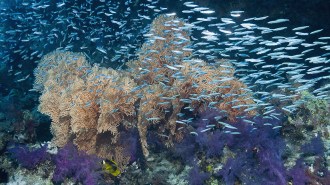All Stories
-
 Particle Physics
Particle PhysicsMuon magnetism could hint at a breakdown of physics’ standard model
After two decades, a new measurement of the muon magnetic anomaly reinforces earlier hints that its value disagrees with standard physics.
-
 Genetics
GeneticsEurope’s oldest known humans mated with Neandertals surprisingly often
DNA from ancient fossils suggests interbreeding regularly occurred between the two species by about 45,000 years ago, two studies find.
By Bruce Bower -
 Animals
AnimalsTiny crystals give a plain fish twinkling, colorful dots under light
Fishes’ flashing photonic crystals may provide inspiration for ultra-miniaturized sensors that work in a living body.
By Susan Milius -
 Life
LifeYawning helps lions synchronize their groups’ movements
A lion yawn is contagious, and when lions start yawning together, they start moving together. Synchronization may be key for group hunters like lions.
By Jake Buehler -
 Tech
Tech‘Pipe Dreams’ flushes out hope in an unexpected place: the toilet
A new book shows how reimagined toilets will allow humans to use pee and poop as natural resources.
-
 Earth
EarthA spike in Arctic lightning strikes may be linked to climate change
Global warming may be revving up summer thunderstorms in the Arctic, leading to skyrocketing numbers of lightning strikes.
-
 Humans
HumansNew depictions of ancient hominids aim to overcome artistic biases
Artists’ intuition instead of science drive most facial reconstructions of extinct species. Some researchers hope to change that.
-
 Physics
PhysicsNewly made laser-cooled antimatter could test foundations of modern physics
Physicists have finally used laser cooling to tame unruly antimatter atoms. That could allow new tests of symmetry and Einstein’s theory of gravity.
-

-

Celebrating 100 years of unbiased journalism
Maya Ajmera reflects on her tenure as publisher of Science News and celebrates its 100 years of unbiased journalism.
By Maya Ajmera -
 Materials Science
Materials ScienceMicroscopic images reveal the science and beauty of face masks
Important insights into the particle-filtering properties of different fabrics also offer a sense of the unseen, textured world of face masks.
-
 Science & Society
Science & SocietyWe’ve covered science for 100 years. Here’s how it has — and hasn’t — changed
Today’s researchers pursue knowledge with more detail and sophistication, but some of the questions remain the same.